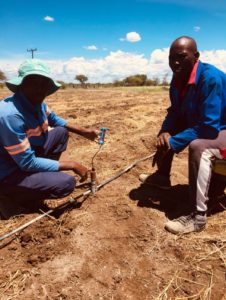In the dry and arid climate of the Tuli Karoo System, located at the confluence of Botswana, South Africa and Zimbabwe, irrigated agriculture can bridge dry spells and droughts, boost climate change adaptation for increased food production. Limited water resources call for more efficient irrigation water use, to stretch limited water resources and reduce environmental impacts. As part of the USAID project Conjunctive Water Management across borders in the SADC Region: Generating Principles through fit-for-purpose practice, innovative water and nutrient management tools are being implemented. Tools consist of Chameleon sensors and Wetting Front Detectors (WFDs) that provide real-time data to facilitate enhanced smallholder farmers’ agricultural productivity and resilience. Fieldwork started according to plan, with the purchasing of equipment and conducting site visits until the first cases of Covid-19 were reported in Africa. Thereafter travel and site visit restrictions were introduced. Hence, fieldwork and research, as well as other sectors, had to find a new normal too.

Taking a soil moisture levels from an installed chameleon sensor using a reader in a smallholder irrigation field, Molalatau, Botswana (Manuel Magombeyi, IWMI)
Through February 2020, fieldwork in the Tuli Karoo was business as usual. In collaboration with local agricultural extension officers from Botswana and Zimbabwe, farmers were trained on the installation and use of data from the tools for improved irrigation decision-making.
This training highlighted, how improved irrigation decisions could result in reduced water use, nutrient loss and operational costs, thereby increasing crop water productivity. The farmers conceded that water and nutrient savings were possible as they reflected on their practice of applying constant irrigation volumes from planting to harvest without adjusting water requirements at different crop growth stages.
Since the new normal from mid-March, farmers have been learning and adjusting their practices for beans, tomatoes and green peppers using the tools and comparing it against their traditional practices in a “control” plot. Dr Manuel Magombeyi, who leads this project component, has found his new-normal of supporting farmers remotely. He receives field data through the https://via.farm sharing platform and provides remote support to farmers via WhatsApp and text messages. This has created a virtual co-learning platform for farmers, extension and researchers across countries sharing the same water resources. Looking ahead, a comparison of the performance of the two crop management practices in terms of crop water use, energy, labour, nutrient loss and yield will be undertaken at harvest and application of the technologies at new sites explored.








